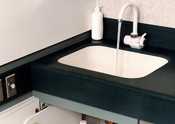Correctional Health Care Workers
NOTE: This page is archived for historical purposes and is no longer being maintained or updated.
Be Sure Your Workers are Using Safe Work Practices

As an administrator or manager, there are many reasons why you should be ensuring the use of safe work practices. First, you want your workers to be safe. Studies have found that following certain safe work practices result in a lower chance of being exposed to a bloodborne disease. And second, as an employer it’s your responsibility to assure the use of work practice controls under the Occupational Safety and Health Administration (OSHA) Bloodborne Pathogens Standard.
Help protect your workers from bloodborne diseases
There are many ways you can help protect your workers from bloodborne viruses. Here are just a few. For more information about required work practices, refer to the OSHA Bloodborne Pathogens Standard.



- Be sure your workers know they can be vaccinated against hepatitis B.
Employers are required by the OSHA Bloodborne Pathogens Standard to provide hepatitis B vaccination for free to employees who may be exposed to blood while at work.
If your employees decide not to get vaccinated, the OSHA standard requires you keep signed hepatitis B declination forms on file.
- Be sure your workers use appropriate personal protective equipment (PPE).1 This can prevent blood and other body fluids* from coming in contact with their skin, eyes, and mouth.1,2,3
- You must provide appropriate forms of personal protective equipment (PPE) that are in good condition and readily accessible to your workers, such as:
- Aprons
- Face shields
- Gloves
- Goggles
- Gowns
- PPE must be available in sizes to fit each of your workers and should be kept in areas where PPE may be needed.1,2
- Be sure your workers handle and dispose of sharps the right way. This can lower their chances of getting stuck with a used needle or sharp.
- Be sure they discard used needles, scalpel blades, syringes, and other sharps into a sharps disposal container.1,3
- Be sure used sharps are not being bent, broken, or recapped unless no alternative is possible.1,3In this case, a medical device or the one-handed technique must be used.1
- Be sure sharps disposal containers are readily accessible and kept as close to your workers’ work areas as possible.1
Using safer medical devices, such as needleless systems and sharps with built-in safety features, can lower the chance of a needlestick. When choosing new devices, you are required by the OSHA Bloodborne Pathogens Standard to get input from workers who are not managers and who directly care for patients.1
- Your workers must be properly trained on new devices before using them.1,2They may actually have a higher chance of being exposed if they don’t know how to use a new device correctly.
- Be sure your workers wash their hands properly.1Proper hand washing can get rid of most viruses and bacteria.4
Because of small defects, gloves may not completely protect against viruses and bacteria. Basic hand washing before and after wearing gloves can get rid of most germs.2,3
- Provide your workers with an antiseptic hand cleanser.1,2,4These alcohol-based hand rubs effectively reduce germs when hands are not heavily soiled and are a good alternative to washing with soap and water.1,4However, OSHA still requires your workers to wash their hands with soap and water when it is possible.1
- Be sure your workers disinfect surfaces and objects that have been contaminated with blood or other body fluids*.1This can lower a worker’s chance of being exposed to a bloodborne disease through cross-contamination.2
You must provide an EPA-approved disinfectant for your workers to wipe down contaminated surfaces.1,2,3 EPA-registered tuberculocidal disinfectants are best for cleaning surfaces contaminated with blood.5Disinfectants that kill the bacteria that cause tuberculosis can also kill HIV, hepatitis B and hepatitis C viruses.
Work surfaces and reusable equipment must be disinfected if they have, or may have, come in contact with blood or other body fluids.*1
To learn more about other required safe work practices, refer to the OSHA Bloodborne Pathogens Standard . For recommended work practice that may also lower exposures, refer to the Centers for Disease Control and Prevention reports .
* “Other body fluids” includes other potentially infectious material, such as semen, vaginal secretions, cerebrospinal, synovial, pleural, peritoneal, pericardial, and amniotic fluids, and any other body fluid that contains visible blood.
- (29 CFR Part 1910.1030) Bloodborne Pathogen Standard . Washington, DC: U.S. Department of Labor, Occupational Safety and Health Administration.
- CDC (Centers for Disease Control and Prevention). 1989. Guidelines for Prevention of Transmission of Human Immunodeficiency Virus and Hepatitis B Virus to Health-Care and Public-Safety Workers A Response to P.L. 100-607 The Health Omnibus Programs Extension Act of 1988 . MMWR Vol. 38(S-6): 3-37.
- CDC (Centers for Disease Control and Prevention). 1987. Recommendations for Prevention of HIV Transmission in Health-Care Settings . MMWR Vol. 36(SU02); 001
- DC (Centers for Disease Control and Prevention). 2002. Guideline for Hand Hygiene in Health-Care Settings: Recommendations of the Healthcare Infection Control Practices Advisory Committee and the HICPAC/SHEA/APIC/IDSA Hand Hygiene Task Force . MMWR. Vol. 51(RR16);1-44.
- OSHA (Occupational Safety and Health Administration). Standard Interpretations: 02/28/1997 - EPA-Registered Disinfectants for HIV and HBV .
- Page last reviewed: August 18, 2010 (archived document)
- Content source:


 ShareCompartir
ShareCompartir